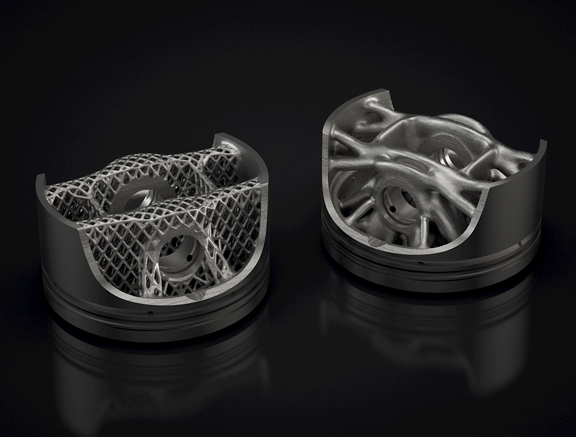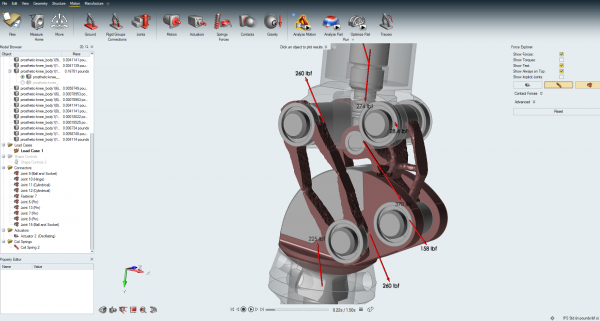Generative Design Challenges Old Paradigms from the Parametric Era
CAD evolves from passive geometry sculpting engine to design collaborator.

Lattice optimization is a module available only in the Windows OS version of Frustum Generate. Image courtesy of Frustum.
Latest News
November 12, 2018
Usually abbreviated as CAD, the term computer-aided design has always been a bit of a misnomer. Sure, it’s an industry-recognized term to describe the wide range of 2D drafting and 3D modeling software programs that engineers, designers and architects have come to rely on. Yet, truth be told, the software hardly provides any design assistance.
CAD software efficiently executes the user’s commands, whether it’s to sketch a circle with 1.5 cm diameter, extrude a 2D-profile to a 2-inch height, or add a curve to a corner. However, it would be a stretch to call the convenience of digital drafting and modeling “design assistance.” Now, the emerging crop of generative design software is poised to restore the missing aid to computer aided design. With generative design, users can indeed ask for design suggestions and recommendations from the software itself, as though it were a living, breathing colleague.

The Dawn of Generative Design
The genesis of generative design can be traced back to simulation software, with topology optimization as the intermediary evolutionary step. Generative design software uses time-tested structural, fluid and thermal simulation technologies; however, instead of asking the user to provide the target geometry, generative design software suggests and recommends appropriate geometry or topology based on user input.
In traditional simulation, the user supplies the geometry (for example, the shape of a new bracket), then asks the software to calculate how the design might perform under a given set of stresses, forces and pressures. By contrast, in generative design software programs, the user supplies the stresses, forces and pressures as input parameters, then asks the software to recommend the best (or optimal) topology to counter them.
To respond to the user’s inquiry, the software uses known material properties, structural mechanics and thermodynamics to decide where material reinforcement is necessary and where it can be reduced. Therefore, generative design is arguably simulation hidden from plain sight. But unlike simulation, which deals with one problem at a time, generative design explores a wide scope of design options to identify the best. To perform that exploration quickly, many generative design programs are written to take advantage of parallel processing, a common feature of GPU-accelerated workstations, such as those offered by Dell equipped with NVIDIA GPUs.
From Parametric to Generative
Recognizing the appeal of generative design, most major CAD software developers have begun adding generative features into their flagship products. Autodesk represents an early explorer of the new paradigm. With the launch of Project Dreamcatcher, Autodesk began incubating its version of generative design as an experimental technology. Autodesk generative design software taps into the power of NVIDIA GPUs to run simulations on numerous design scenarios and allows for massive exploration of the design space, empowering designers to rapidly analyze the input and generate the recommended design options.
In June 2017, when the company felt the technology was robust enough, it introduced it into Autodesk Netfabb software, which targets the additive manufacturing (AM) industry. Pairing generative design with AM is a wise strategy, because the complex geometric shapes recommended by the software often prove impossible or impractical to fabricate using traditional manufacturing methods.
Since then, Autodesk rival Dassault Systemes has also added generative design to its flagship mechanical CAD program, SolidWorks. In SolidWorks 2018, the technology appears as Topology Study. Another manufacturing software titan Siemens PLM Software has also added topology optimization to its mainstream CAD program Solid Edge. The trend shows no signs of slowing down. We can expect rivals of these software giants to introduce their own countermeasures in their portfolios.
One of the early topology optimization products to target design engineers, Altair Inspire (previously branded solidThinking Inspire) continues to refine its features for ease of use. The product has evolved to become capable of lattice-structure optimization and overhang control, among others. In October, Altair acquired SIMSOLID, a simulation startup that offers mesh-less simulation to speed up pre-processing. SIMSOLID’s technology is expected to be integrated into Altair products.
Because many CAD vendors have successful CAD products in their lineups, they will most likely augment the existing CAD software with generative design features. For new players starting from scratch, it’s a different story.
Generative Design Brings New Vendors
Founded four years ago in 2014, Frustum says its mission is “to make Generative Design functional for designers and engineers.” Its flagship product is Generate, previously only available as a web product but recently made available also on Windows desktops. Frustum’s technology has been licensed to Siemens PLM Software, for integration into the latter’s NX and Solid Edge software.
AM system developer Desktop Metal, founded in 2015, says it wants to launch “a new approach to metal 3D printing—single pass jetting (SPJ).” To enable its vision, the firm also developed a software product titled Live Parts. Though currently an experimental technology, the software has attracted significant attention at trade shows and conferences where it was demonstrated.
“Similar to how plants grow, there are no straight lines in parts except where needed for mounting regions, symmetries, or keep out zones. This makes them well suited for additive manufacturing processes, where typical design limitations don’t apply,” the company says, describing the basic principle of optimization used by Live Parts. The software is GPU-accelerated to take advantage of the graphics unit’s parallel processing capacity for multiphysics calculation.
Manufacturing Constraints Are the Next Steps
Currently, the focus of generative design technologies is the ability to identify the best shape or topology based on user inputs. Pioneering developers are now working to incorporate not only stresses and loads but also preferred manufacturing methods in how the software identifies the optimal shape. Frustum’s Generate V1.4, for example, includes manufacturing constraints. It comes as the ability to specify slice planes, symmetry planes, extrusion and overhang reduction.
The ability to take these demands into account means the resulting geometry is more suitable for the target production method, whether it is milling or 3D printing. Such innovations can reduce geometry rework due to unsuitability for the desired manufacturing method, bringing generative design to the next level of usefulness.
Subscribe to our FREE magazine, FREE email newsletters or both!
Latest News







